(By Duncan
Hunter, Dec. 6, 2013 -- Controversy erupted this week after
Rep. Duncan Hunter, told a C-SPAN interviewer)
[The problem with the Obama
administration’s nuclear deal with Iran
is that it pretends Iran Iran
- In Tehran Friday Prayers, Assembly of Experts member Hojjat al-Eslam Ahmad Khatami praised Iran’s students for their history of standing against America and “being the front line against sanctions,” while warning them “the seditionists are trying to use you as tools.” Khatami also praised the nuclear negotiations team for working within the Supreme Leader’s guidelines and negotiating within the spirit of Ashura:
- Khatami then criticized the US: “After the negotiations, Obama again noted that all options are on the table. He lied and said that we have an atomic bomb. What manners are these? We know that Obama is among the rudest leaders in the world.”
- “However, if there is the smallest indicator of a lack of adherence, the Quran says that you cancel the contract, and that if the enemy wants to betray you, there is no contract.”
- “After the [2009] Sedition, the Supreme Leader used the word ‘sedition’ more than 200 times in his speeches. People who say something else and do not say ‘sedition’ are taking actions in opposition to the line of the Supreme Leader.”
- Khatami claimed that the “sedition” was not “a crime” but a “betrayal”: “Seditionists spoiled an opportunity for 40 million people in the elections. They committed a crime offensive to Hossein and the Imam [Khomeini]. Burning his picture, killing innocents, attacking Basij and Sepah [IRGC] bases, burning mosques, destroying public property and having intimate connections with foreigners are issues that will not easily leave the minds of the people.”
- “It is felt that some of the Seditionists are seeking work [in government] today. They abuse the present conditions and see that some of their friends and partners in crime have taken posts, so they have become cheeky and demanding.”
- “We say to the Seditionists that the population of tens of millions from [2009] has not died, and if they want to establish a sedition, this population will enter the scene with the same glory and gather up the Seditionists.”
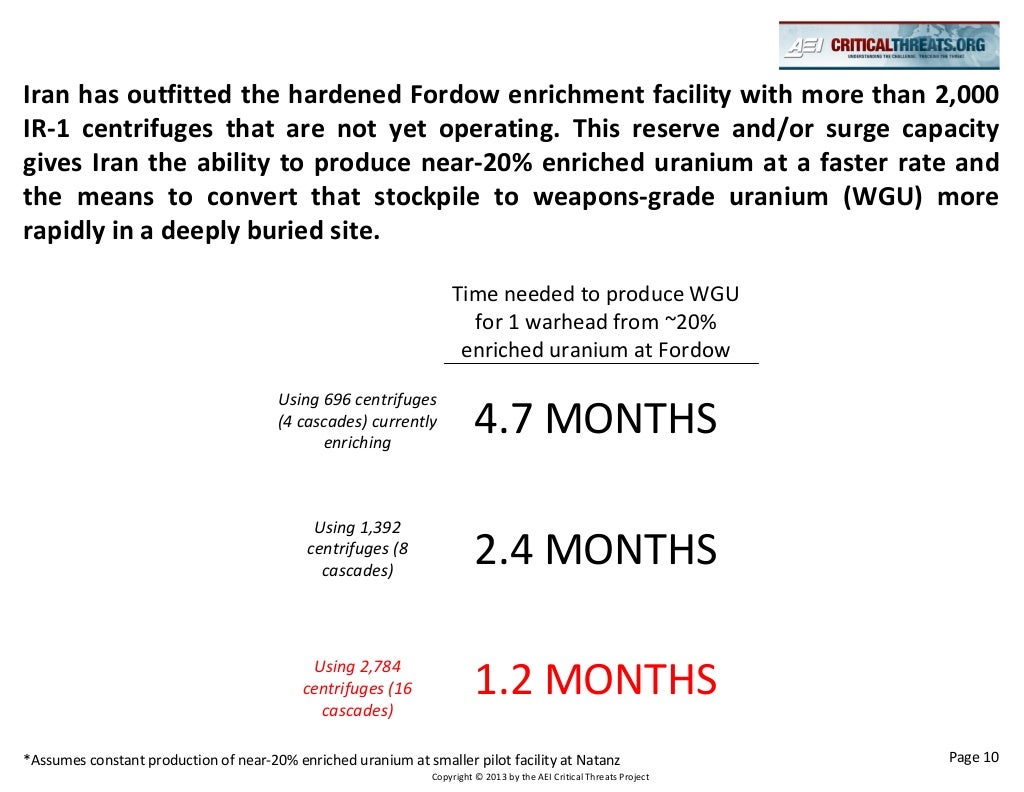
Reaching an agreement with
Iran to verifiably dismantle
its nuclear program or agree to significant reductions while fully opening its
doors and books to inspectors is most definitely in America Iran Iran
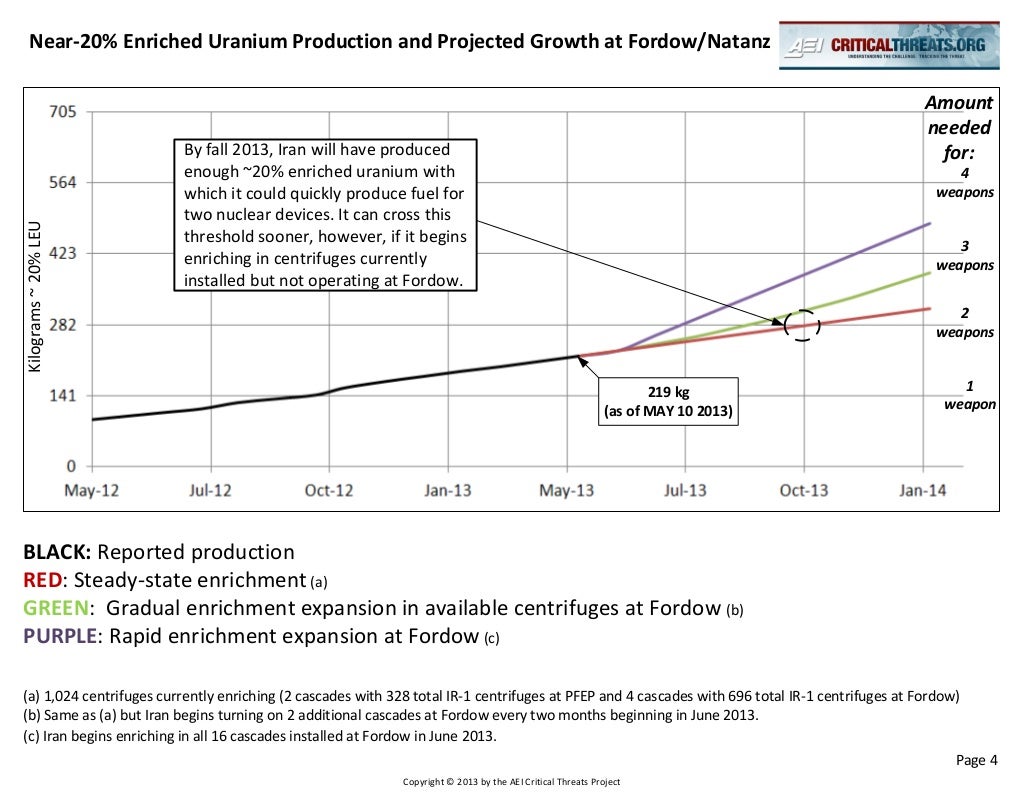
The long-term objective is
to prevent a nuclear Iran Iran
All
of this underscores why it remains in the world’s interest for America to diplomatically but effectively halt Iran Iran
Obama and the Iran Nuke Deal
November 25, 2013
An interim accord on Iran's nuclear program was struck in Geneva early on November 24 that holds parts of the program where they are now and provides Iran with up to $7 billion in sanctions relief. The accord has been described as historic, for different reasons. U.S. President Barack Obama says it has "opened up a new path toward a world that is more secure"; Israeli Prime Minister Benjamin Netanyahu criticized it as "an historic mistake." The United States and its partners in the P5+1 now have at least six months – and likely more – to work out a "comprehensive solution" with Iran. The text of the interim accord confirms that this solution would include an important concession to Iran: the right to keep "a mutually defined enrichment program."
Under the interim accord, Iran has agreed to stop producing 20 percent enriched uranium gas and to convert its existing stockpile of this material, which is close to weapon-grade, into either uranium oxide or to a lower level of enriched uranium gas. This is the only important limitation on Iran's nuclear work achieved by the deal.
The other elements in this accord require Iran to pause some of its nuclear work, rather than reversing the program in any way. For instance, the nearly 9,000 first-generation centrifuges producing up to five percent enriched uranium gas will continue to operate. At the present production rate, this would yield an additional 1.4 tons of low-enriched uranium over the next six months. Iran has agreed to convert this output into oxide form. No mention is made of the just over seven tons of this material that are currently stockpiled in Iran – enough to fuel six nuclear weapons with further enrichment and processing. Iran is also restricted from using already installed (but not operational) centrifuges at its Natanz and Fordow plants for uranium enrichment, and from installing additional centrifuges, including the more advanced IR-2m, at either plant. While Iran has committed not to manufacture new centrifuges during this interim period, no centrifuges are dismantled as a result of the deal. Major work related to the heavy water reactor at Arak is suspended for six months, including fuel production and testing and the installation of major components. However, there is no indication that Iran plans to abandon the reactor. Once online, the reactor would provide Iran with a source of plutonium – a potential nuclear weapons material – from the reactor's spent fuel.
In order to monitor Iran's compliance with these restrictions, the accord sets forth an "enhanced monitoring" arrangement, under which Iran would allow daily access by international inspectors to Natanz and Fordow. Inspectors would also gain "managed access" to centrifuge production and assembly workshops and to uranium mines and mills. Other transparency measures include the provision of information about planned nuclear facilities and updated information about existing facilities, like the Arak reactor.
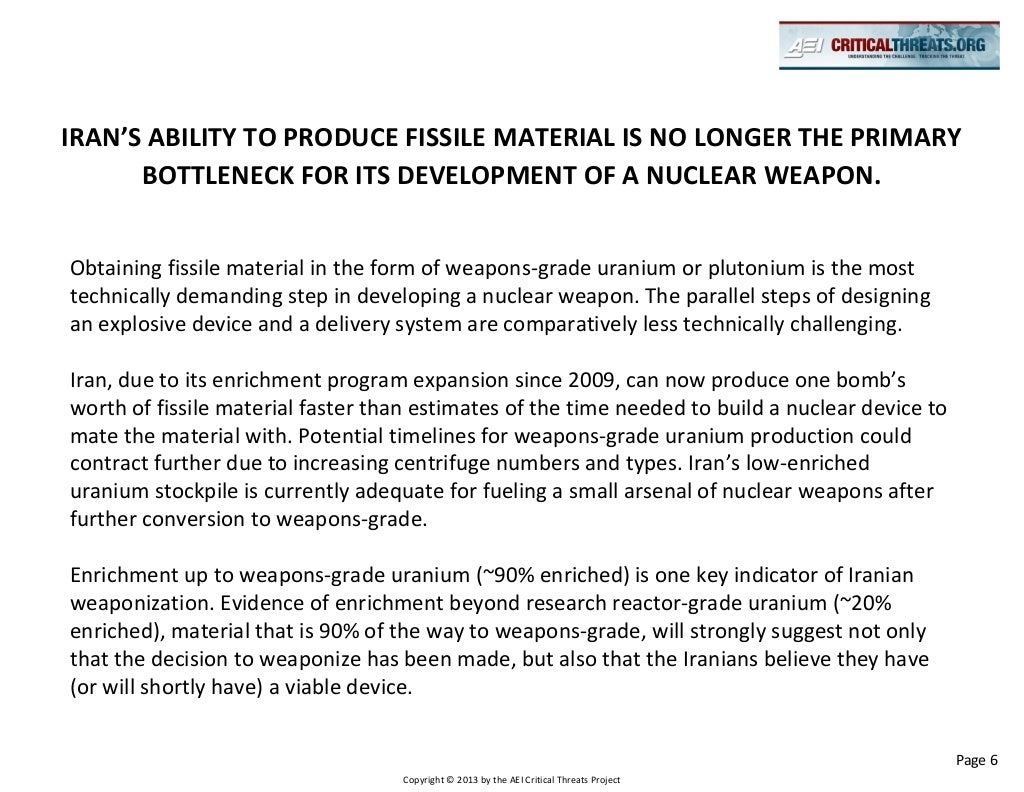
In return for these nuclear restrictions and increased transparency, Iran received a much-needed injection of cash – reportedly about $4.2 billion worth – that has been frozen in overseas accounts. In addition, the United States and its partners will not seek to decrease further Iran's crude oil exports, and U.S. and European sanctions on Iranian petrochemical exports and gold and precious metals trade will be suspended. U.S. sanctions on Iran's auto industry will also be suspended and Iran will be allowed to receive spare parts for its ailing civilian aircraft. For its part, the European Union will increase "to an agreed amount" the threshold for transactions requiring preauthorization. And, as long as this interim accord remains in effect, Iran would not be subject to further nuclear-related sanctions by the United Nations, the European Union, or the United States. Taken together, the Obama administration estimates the sanctions relief to represent up to $7 billion. Israeli officials and other parties critical of the deal estimate that the relief is several times that amount.
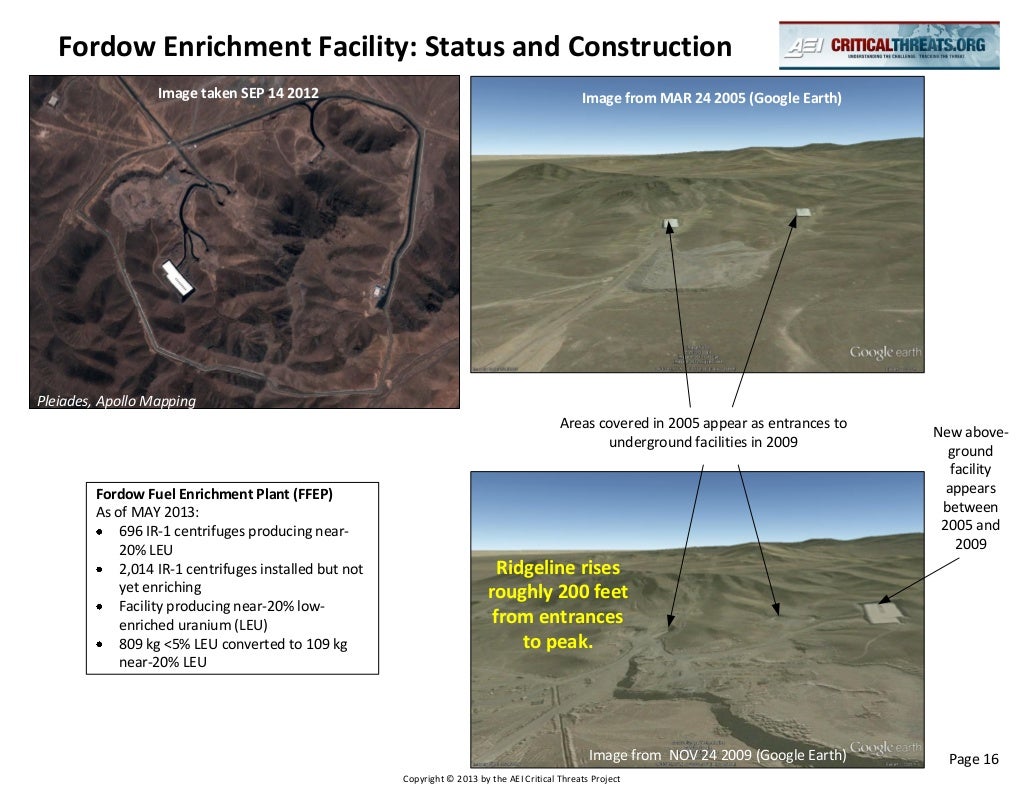 The deal is meant to be "a first step toward a comprehensive solution that addresses our concerns with the Islamic Republic of Iran's nuclear program," according to President Obama. The parameters of this solution, which the parties aim to conclude within one year, are sketched out at the end of the interim accord. They include Iran's ratification of a protocol allowing for enhanced inspections, the lifting of all nuclear-related national and multilateral sanctions, civil nuclear cooperation for Iran, and a "mutually defined enrichment program" in Iran that meets Iran's "practical needs." Such a program would be limited in terms of scope, enrichment level, and stockpile size, for a "period to be agreed upon." This last point suggests that Iran may be willing to limit the scope of its enrichment for a period of time in order to end all sanctions but that these limitations would not be permanent.
The deal is meant to be "a first step toward a comprehensive solution that addresses our concerns with the Islamic Republic of Iran's nuclear program," according to President Obama. The parameters of this solution, which the parties aim to conclude within one year, are sketched out at the end of the interim accord. They include Iran's ratification of a protocol allowing for enhanced inspections, the lifting of all nuclear-related national and multilateral sanctions, civil nuclear cooperation for Iran, and a "mutually defined enrichment program" in Iran that meets Iran's "practical needs." Such a program would be limited in terms of scope, enrichment level, and stockpile size, for a "period to be agreed upon." This last point suggests that Iran may be willing to limit the scope of its enrichment for a period of time in order to end all sanctions but that these limitations would not be permanent.
Obama administration officials, whose secret bilateral meetings with Iran since last March reportedly paved the way for this interim deal, will now work to reach a comprehensive settlement. The main question is whether Congress will suspend the imposition of new sanctions during this interim period. Some congressional leaders, including Democrats, have reacted critically to the deal. Senator Charles Schumer of New York said he was "disappointed" because the interim deal "does not seem proportional. Iran simply freezes its nuclear capabilities while we reduce the sanctions." He and Republican colleagues in the Senate are likely to push for the adoption of additional sanctions when Congress returns from recess in early December. Such sanctions may have a built-in six month window before they hit, in order to test Iran's willingness to accept sufficient curbs on its nuclear work.
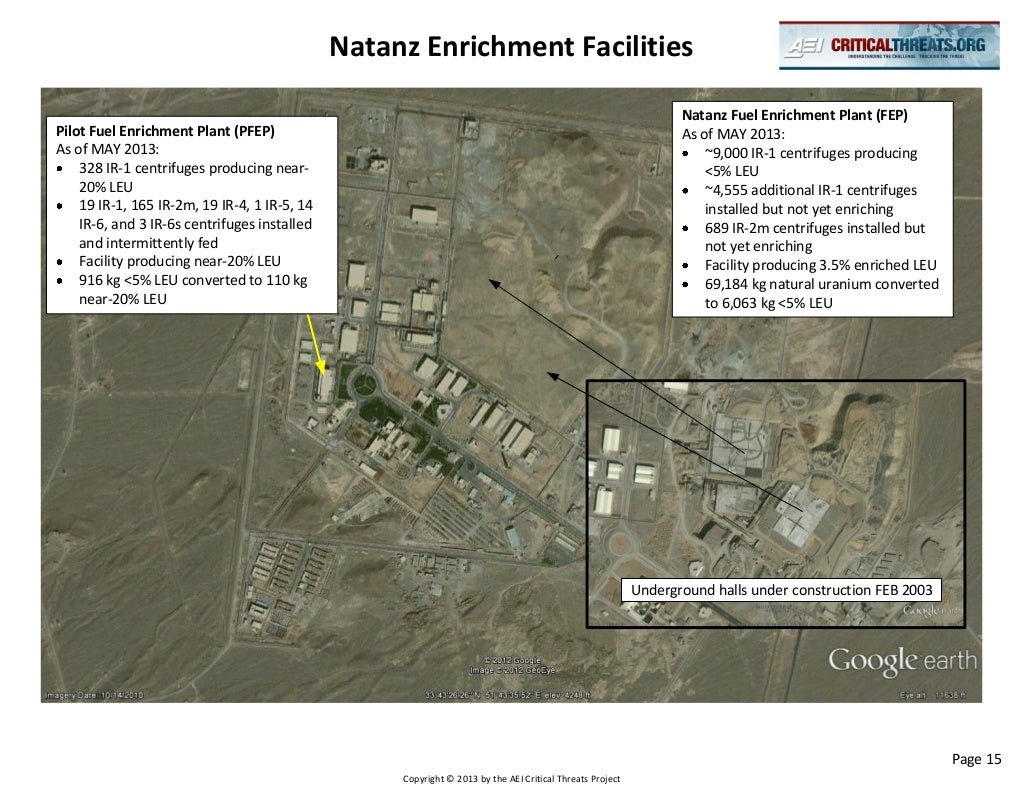
The Senate has so far put off discussion of the sanctions bill overwhelmingly passed by the House of Representatives in July. The Nuclear Iran Prevention Act of 2013 (H.R. 850) aims to further cut into Iran's oil revenue by requiring countries that continue to purchase Iranian crude to reduce their combined purchases by one million barrels per day within one year. The bill also targets Iran's construction, automotive, and mining sectors, and imposes additional indirect sanctions on foreign entities that engage in significant commercial trade with Iran.
For its part, the administration has insisted that the "sanctions architecture" will be kept in place under the interim deal, and has warned with Congress to hold off on new sanctions, which could scupper further talks and initiate a "march to war."
The interim deal follows a more limited agreement struck between Iran and the International Atomic Energy Agency on November 11 that provides the Agency with "managed access" to two nuclear sites and the promise of better information sharing from Iran. This agreement comes after a dozen rounds of technical discussions with the Agency over nearly two years. Iran has three months to fulfill the straightforward requirements of the Framework, while the stickiest and most pressing parts of the IAEA's ongoing investigation – related to allegations that Iran pursued nuclear weapon-relevant work – are not addressed.
The deal struck with the IAEA, and Iran's position during talks in Geneva, suggest that while Tehran may be willing to make marginal concessions, it has no intention of permanently rolling back its robust nuclear infrastructure. In fact, the IAEA-Iran agreement suggests just the opposite. In it, Iran pledges to provide information about "all new research reactors," about the "16 sites designated for the construction of nuclear power plants," and most troubling of all, about announcements related to "additional enrichment facilities" and "laser enrichment technology."
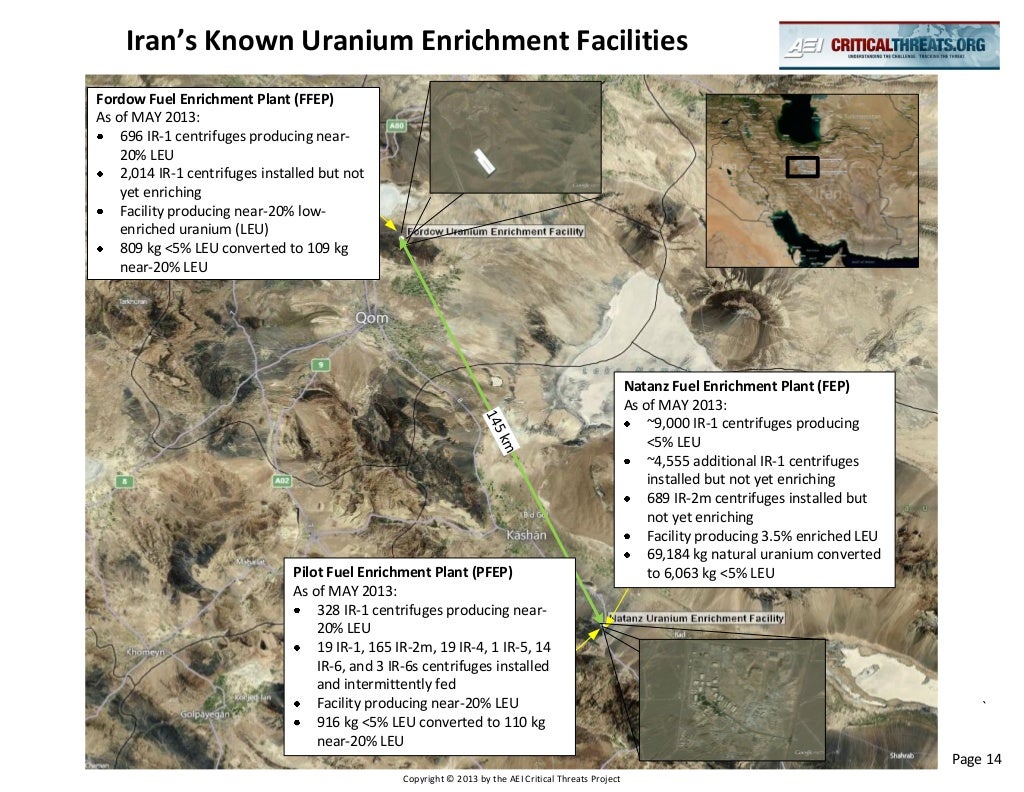
The IAEA's November 14 report on Iran's' nuclear progress supports this conclusion. According to the Agency, Iran's uranium enrichment infrastructure has remained steady since August, with few additional centrifuges installed and no additional centrifuges enriching uranium. Still, Iran has over 1,000 advanced IR-2m centrifuges installed at Natanz and has completed preparatory installation work on a further 2,000 centrifuges. While no IR-2m centrifuges are currently enriching uranium, they are capable of doing so at a rate several times faster than the first-generation IR-1 centrifuges now in use. Iran has over 15,000 such centrifuges installed at Natanz, of which just over half were operating in early November. These machines are producing uranium enriched to 3.5 percent U-235. As of early November, Iran's stockpile of this low-enriched uranium gas amounted to some 7,150 kg, an amount sufficient -- with further enrichment and processing -- to fuel six implosion bombs, according to Wisconsin Project estimates. For details, see "Iran's Nuclear Timetable."
Iran has also produced over 400 kg of medium-enriched uranium gas, which is much closer to weapons-grade, although about half of this amount has been converted to research reactor fuel. The Wisconsin Project estimates that the remaining stockpile, about 200 kg, would be sufficient to fuel one nuclear weapon if the material were further enriched. Media reports, citing Israeli sources, estimate that Iran would need about 240 kg of this 20 percent enriched uranium gas to fuel one weapon.
Iran’s effort to produce 20 percent enriched uranium is based principally at the underground and fortified Fordow plant. Iran is now enriching uranium in only 696 of the 2,700 IR-1 centrifuges installed there. Once fully operational, Fordow could produce about 40 kg of this 20 percent uranium each month. If further enriched to weapons-grade, the Wisconsin Project estimates that this material could provide enough fuel for approximately three nuclear weapons every year.
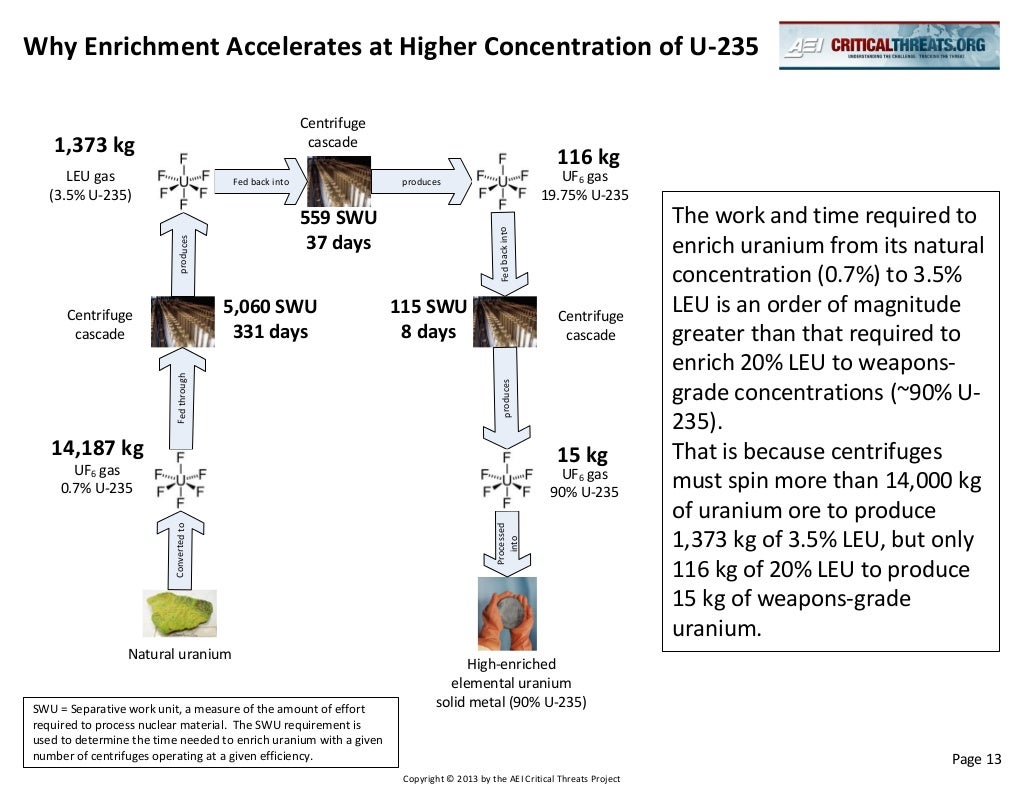
Iran's Nuclear Timetable
Under the interim accord, Iran has agreed to stop producing 20 percent enriched uranium gas and to convert its existing stockpile of this material, which is close to weapon-grade, into either uranium oxide or to a lower level of enriched uranium gas. This is the only important limitation on Iran's nuclear work achieved by the deal.
The other elements in this accord require Iran to pause some of its nuclear work, rather than reversing the program in any way. For instance, the nearly 9,000 first-generation centrifuges producing up to five percent enriched uranium gas will continue to operate. At the present production rate, this would yield an additional 1.4 tons of low-enriched uranium over the next six months. Iran has agreed to convert this output into oxide form. No mention is made of the just over seven tons of this material that are currently stockpiled in Iran – enough to fuel six nuclear weapons with further enrichment and processing. Iran is also restricted from using already installed (but not operational) centrifuges at its Natanz and Fordow plants for uranium enrichment, and from installing additional centrifuges, including the more advanced IR-2m, at either plant. While Iran has committed not to manufacture new centrifuges during this interim period, no centrifuges are dismantled as a result of the deal. Major work related to the heavy water reactor at Arak is suspended for six months, including fuel production and testing and the installation of major components. However, there is no indication that Iran plans to abandon the reactor. Once online, the reactor would provide Iran with a source of plutonium – a potential nuclear weapons material – from the reactor's spent fuel.
In order to monitor Iran's compliance with these restrictions, the accord sets forth an "enhanced monitoring" arrangement, under which Iran would allow daily access by international inspectors to Natanz and Fordow. Inspectors would also gain "managed access" to centrifuge production and assembly workshops and to uranium mines and mills. Other transparency measures include the provision of information about planned nuclear facilities and updated information about existing facilities, like the Arak reactor.

In return for these nuclear restrictions and increased transparency, Iran received a much-needed injection of cash – reportedly about $4.2 billion worth – that has been frozen in overseas accounts. In addition, the United States and its partners will not seek to decrease further Iran's crude oil exports, and U.S. and European sanctions on Iranian petrochemical exports and gold and precious metals trade will be suspended. U.S. sanctions on Iran's auto industry will also be suspended and Iran will be allowed to receive spare parts for its ailing civilian aircraft. For its part, the European Union will increase "to an agreed amount" the threshold for transactions requiring preauthorization. And, as long as this interim accord remains in effect, Iran would not be subject to further nuclear-related sanctions by the United Nations, the European Union, or the United States. Taken together, the Obama administration estimates the sanctions relief to represent up to $7 billion. Israeli officials and other parties critical of the deal estimate that the relief is several times that amount.
 The deal is meant to be "a first step toward a comprehensive solution that addresses our concerns with the Islamic Republic of Iran's nuclear program," according to President Obama. The parameters of this solution, which the parties aim to conclude within one year, are sketched out at the end of the interim accord. They include Iran's ratification of a protocol allowing for enhanced inspections, the lifting of all nuclear-related national and multilateral sanctions, civil nuclear cooperation for Iran, and a "mutually defined enrichment program" in Iran that meets Iran's "practical needs." Such a program would be limited in terms of scope, enrichment level, and stockpile size, for a "period to be agreed upon." This last point suggests that Iran may be willing to limit the scope of its enrichment for a period of time in order to end all sanctions but that these limitations would not be permanent.
The deal is meant to be "a first step toward a comprehensive solution that addresses our concerns with the Islamic Republic of Iran's nuclear program," according to President Obama. The parameters of this solution, which the parties aim to conclude within one year, are sketched out at the end of the interim accord. They include Iran's ratification of a protocol allowing for enhanced inspections, the lifting of all nuclear-related national and multilateral sanctions, civil nuclear cooperation for Iran, and a "mutually defined enrichment program" in Iran that meets Iran's "practical needs." Such a program would be limited in terms of scope, enrichment level, and stockpile size, for a "period to be agreed upon." This last point suggests that Iran may be willing to limit the scope of its enrichment for a period of time in order to end all sanctions but that these limitations would not be permanent.Obama administration officials, whose secret bilateral meetings with Iran since last March reportedly paved the way for this interim deal, will now work to reach a comprehensive settlement. The main question is whether Congress will suspend the imposition of new sanctions during this interim period. Some congressional leaders, including Democrats, have reacted critically to the deal. Senator Charles Schumer of New York said he was "disappointed" because the interim deal "does not seem proportional. Iran simply freezes its nuclear capabilities while we reduce the sanctions." He and Republican colleagues in the Senate are likely to push for the adoption of additional sanctions when Congress returns from recess in early December. Such sanctions may have a built-in six month window before they hit, in order to test Iran's willingness to accept sufficient curbs on its nuclear work.

The Senate has so far put off discussion of the sanctions bill overwhelmingly passed by the House of Representatives in July. The Nuclear Iran Prevention Act of 2013 (H.R. 850) aims to further cut into Iran's oil revenue by requiring countries that continue to purchase Iranian crude to reduce their combined purchases by one million barrels per day within one year. The bill also targets Iran's construction, automotive, and mining sectors, and imposes additional indirect sanctions on foreign entities that engage in significant commercial trade with Iran.
For its part, the administration has insisted that the "sanctions architecture" will be kept in place under the interim deal, and has warned with Congress to hold off on new sanctions, which could scupper further talks and initiate a "march to war."
The interim deal follows a more limited agreement struck between Iran and the International Atomic Energy Agency on November 11 that provides the Agency with "managed access" to two nuclear sites and the promise of better information sharing from Iran. This agreement comes after a dozen rounds of technical discussions with the Agency over nearly two years. Iran has three months to fulfill the straightforward requirements of the Framework, while the stickiest and most pressing parts of the IAEA's ongoing investigation – related to allegations that Iran pursued nuclear weapon-relevant work – are not addressed.
The deal struck with the IAEA, and Iran's position during talks in Geneva, suggest that while Tehran may be willing to make marginal concessions, it has no intention of permanently rolling back its robust nuclear infrastructure. In fact, the IAEA-Iran agreement suggests just the opposite. In it, Iran pledges to provide information about "all new research reactors," about the "16 sites designated for the construction of nuclear power plants," and most troubling of all, about announcements related to "additional enrichment facilities" and "laser enrichment technology."

The IAEA's November 14 report on Iran's' nuclear progress supports this conclusion. According to the Agency, Iran's uranium enrichment infrastructure has remained steady since August, with few additional centrifuges installed and no additional centrifuges enriching uranium. Still, Iran has over 1,000 advanced IR-2m centrifuges installed at Natanz and has completed preparatory installation work on a further 2,000 centrifuges. While no IR-2m centrifuges are currently enriching uranium, they are capable of doing so at a rate several times faster than the first-generation IR-1 centrifuges now in use. Iran has over 15,000 such centrifuges installed at Natanz, of which just over half were operating in early November. These machines are producing uranium enriched to 3.5 percent U-235. As of early November, Iran's stockpile of this low-enriched uranium gas amounted to some 7,150 kg, an amount sufficient -- with further enrichment and processing -- to fuel six implosion bombs, according to Wisconsin Project estimates. For details, see "Iran's Nuclear Timetable."
Iran has also produced over 400 kg of medium-enriched uranium gas, which is much closer to weapons-grade, although about half of this amount has been converted to research reactor fuel. The Wisconsin Project estimates that the remaining stockpile, about 200 kg, would be sufficient to fuel one nuclear weapon if the material were further enriched. Media reports, citing Israeli sources, estimate that Iran would need about 240 kg of this 20 percent enriched uranium gas to fuel one weapon.
Iran’s effort to produce 20 percent enriched uranium is based principally at the underground and fortified Fordow plant. Iran is now enriching uranium in only 696 of the 2,700 IR-1 centrifuges installed there. Once fully operational, Fordow could produce about 40 kg of this 20 percent uranium each month. If further enriched to weapons-grade, the Wisconsin Project estimates that this material could provide enough fuel for approximately three nuclear weapons every year.

Iran's Nuclear Timetable
Valerie Lincy and Gary Milhollin
This table estimates how soon Iran could fuel a nuclear weapon. With its thousands of gas centrifuges, and its growing stockpile of enriched uranium, Iran now has the ability to make fuel for nuclear reactors or, by enriching the uranium further, for nuclear warheads. The data below, which is based on reports from the International Atomic Energy Agency, describe Iran’s uranium stockpile, its centrifuges, and the rate at which its nuclear capacity is growing.
As Iran deploys more centrifuges, and increases its stockpile of enriched uranium, it will consolidate its status as a "virtual" nuclear weapon state. Iran's progress towards this status is estimated below [a]. These estimates are based upon the theoretical performance of Iran's existing centrifuges and upon how these centrifuges appear to have performed in the past:

Footnotes:
Highlights:
- By using the approximately 8,800 first-generation centrifuges operating at its Natanz Fuel Enrichment Plant, Iran could theoretically produce enough weapon-grade uranium to fuel a single nuclear warhead in about 1.7 months.
- The more advanced centrifuges being installed at Natanz would allow Iran to produce weapon-grade uranium more quickly.
- Iran's stockpile of low-enriched uranium is now sufficient, after further enrichment, to fuel approximately six nuclear warheads.
As Iran deploys more centrifuges, and increases its stockpile of enriched uranium, it will consolidate its status as a "virtual" nuclear weapon state. Iran's progress towards this status is estimated below [a]. These estimates are based upon the theoretical performance of Iran's existing centrifuges and upon how these centrifuges appear to have performed in the past:
Bomb potential of Iran's low-enriched uranium stockpile
- Amount of uranium hexafluoride (UF6) enriched to approximately 3.5 percent U-235 produced as of November 5, 2013:
10,357 kg [b]
- Amount of this material stored in gaseous form as of November 2013:
7,154.3 kg [c]
- Average daily production rate of this low-enriched UF6 at the Natanz Fuel Enrichment Plant:
7.7 kg [d]
- Amount of this low-enriched UF6 needed to produce a bomb's worth of weapon-grade uranium metal:
1,053 kg [e]
- Number of separative work units (SWUs) needed to accomplish the above [f]:
955 [g]
- Number of first-generation implosion bombs this low-enriched uranium stored in gaseous form could fuel, if further enriched:
6 [h]
- Time needed to convert this low-enriched uranium to one bomb's worth of finished uranium metal enriched to 90 percent U-235:
3 - 12 months [i]
- Date by which Iran's low-enriched uranium stockpile probably was sufficient to fuel one first-generation implosion bomb, if further enriched:
February 2009 [j]
- Approximate number of first generation IR-1 centrifuges being fed with UF6 at the Natanz Fuel Enrichment Plant, as of the last reported visit by IAEA inspectors:
8,800 [k]
- Average number of SWUs each centrifuge appears to be producing:
.76 [l]
- Number of months theoretically needed for these 8,800 centrifuges operating at such a capacity to produce the 955 SWUs theoretically needed to produce weapon-grade fuel for one bomb:
1.7 [m]
- Approximate total number of IR-1 centrifuges installed at the Natanz Fuel Enrichment Plant:
15,420 [n]
Bomb potential of Iran's medium-enriched uranium stockpile
- Amount of medium-enriched uranium hexafluoride (UF6) gas (approximately 20 percent U-235) produced as of November 2013:
410.4 kg [o]
- Amount of this material stored in gaseous forms as of November 2013:
196 kg [p]
- Amount of this material converted to uranium oxide for use in fuel plates, as of November 2013:
213.54 kg [p]
- Amount of this 20 percent enriched UF6 theoretically needed to produce a bomb’s worth of weapon-grade uranium metal:
140 kg [q]
- Average monthly production rate of this 20 percent enriched UF6 at the Natanz pilot plant:
4.8 kg [r]
- Number of first generation IR-1 centrifuges being fed with UF6 at the Natanz pilot plant as of the last reported visit by IAEA inspectors:
328 [s]
- Average monthly production rate of this 20 percent enriched UF6 at the Fordow plant since the last IAEA report:
10 kg [t]
- Number of first generation IR-1 centrifuges being fed with this UF6 at the Fordow fuel enrichment plant as of the last reported visit by IAEA inspectors:
696 [u]
- Total number of IR-1 centrifuges installed at Fordow:
2,710 [v]
- Number of SWUs needed to accomplish the enrichment of a bomb's worth of this 20 percent enriched UF6 to weapon-grade:
292 [w]
- Number of months theoretically needed for the 2,710 IR-1 centrifuges currently installed at Fordow to accomplish the above:
1.7 [x]
Increasing enrichment capacity at the Natanz Fuel Enrichment Plant
Date of IAEA Inventory | IR-1 Centrifuges Being Fed with UF6 | Other IR-1 Centrifuges Installed |
|---|---|---|
| 17 Feb 2007 | 0 | 656 |
| 13 May 2007 | 1,312 | 820 |
| 19 Aug 2007 | 1,968 | 656 |
| 3 Nov 2007 | 2,952 | 0 |
| 12 Dec 2007 | 2,952 | ? |
| 7 May 2008 | 3,280 | 2,624 |
| 30 Aug 2008 | 3,772 | 2,132 |
| 7 Nov 2008 | 3,772 | 2,132 |
| 1 Feb 2009 | 3,936 | 1,968 |
| 1 Jun 2009 | 4,920 | 2,296 |
| 12 Aug 2009 | 4,592 | 3,716 |
| 2 Nov 2009 | 3,936 | 4,920 |
| 31 Jan 2010 | 3,772 | 4,838 |
| 24 May 2010 | 3,936 | 4,592 |
| 28 Aug 2010 | 3,772 | 5,084 |
| 5 Nov 2010 | 4,816 | 3,610 |
| 16 Nov 2010 | 0 | ~ 8,426 |
| 22 Nov 2010 | ~4,592 | ~3,834 |
| 20 Feb 2011 | ~5,184 | ~2,816 |
| 14 May 2011 | ~5,860 | ~2,140 |
| 28 Aug 2011 | ~5,860 | ~2,140 |
| 2 Nov 2011 | ~6,208 | ~1,792 |
| 19 Feb 2012 | 8,808 | 348 |
| 19 May 2012 | 8,818 | 512 |
| 21 Aug 2012 | 9,156 | 270 |
| 10 Nov 2012 | 9,156 | 1,258 |
| 19 Feb 2013 | ~8,990 | ~3,680 |
| 15 May 2013 | ~8,990 | ~4,565 |
| 24 Aug 2013 | 9,156 | 6,260 |
| 9 Nov 2013 | ~8,800 | ~6,620 |
Date of IAEA Inventory IR-2m Centrifuges Being Fed with UF6 IR-2m Centrifuges Installed 19 Feb 2013 0 180 15 May 2013 0 689 24 Aug 2013 0 1,008 9 Nov 2013 0 1,008
Comments
- This assessment assumes that Iran would use 16 kg of weapon-grade uranium (~90 percent U-235) in the finished core of each nuclear weapon. Sixteen kilograms are assumed to be sufficient for an implosion bomb. This was the amount called for in the implosion device Saddam Hussein was trying to perfect in the 1980’s, and the design for such a device has circulated on the nuclear black market, to which Iran has had access. Some experts believe that Iran could use less material, assuming Iran would accept a lower yield for each weapon. According to these experts, Iran could use as few as seven kilograms of this material if Iran’s weapon developers possessed a “medium” level of skill, and if Iran were satisfied with an explosive yield slightly less than that of the bomb dropped on Hiroshima, Japan.[y] If Iran chose to use an amount smaller than 16 kg, the time required to make each weapon would be less than estimated here. Or, in the amount of time estimated here, Iran could make a greater number of weapons. Iran could decide not to use such a smaller amount of weapon-grade uranium if Iran wanted to have more confidence that its weapons would work, or if it wanted to reduce the size of its weapons by reducing the amount of high explosive required.
- Uncertainties about the number of centrifuges that Iran is operating make it difficult to draw a conclusion about the performance of individual machines. An increase or decrease in the production rate could be attributed to the fact that more machines were operating when IAEA inspectors were not present at the plant, rather than because the machines were operating more efficiently.
- Following start-up, centrifuge cascades must be operated for a time without product withdrawal. This process is called passivation.

Footnotes:
[a] The following estimates are based on information in quarterly reports by the International Atomic Energy Agency (IAEA), which is responsible for nuclear inspections in Iran. These quarterly reports are available here: http://www.iranwatch.org/authoring-agency/iaea-report.
[b] According to the IAEA, Iran had an inventory of 7,451 kg of low-enriched UF6 as of October 21, 2012, based on production from the beginning of operations in February 2007. Iran produced a further 2,906 kg of this material through August 10, 2013, for a total stockpile of 10,357 kg.
[c] According to the IAEA, Iran has used some of its stockpiled low-enriched UF6 (~2,880 kg) for the production of 20% enriched uranium gas. Therefore, Iran had approximately 7,154.3 kg of low-enriched UF6 left as of mid-August, 2013.
(d) Iran estimates that it produced a total of 2,253 kg of low-enriched UF6 over 293 days, from October 22, 2012 to August 10, 2013, for an average daily production rate of 7.7 kg.
(e) This is assuming uranium tails of 1% U-235, a feed assay of 3.5% U-235, a product assay of 90% U-235, a 20% loss of material during processing, and that 16 kg of finished uranium metal enriched to 90% are needed for a bomb. See the SWU calculator published by URENCO, a European uranium enrichment consortium: web.archive.org/web/20021226100607/www.urenco.de/trennarbeit/swucal_e.html.
(f) The Separative Work Unit is the standard measure of the effort required to increase the concentration of the fissionable U-235 isotope. See www.urenco.com/Content/89/Glossary.aspx.
(g) Based on the assumptions set forth above (see note e), Iran would need approximately 955 SWUs to bring 1,053 kg of low-enriched UF6 to weapon grade. See the SWU calculator published by URENCO, a European uranium enrichment consortium: web.archive.org/web/20021226100607/www.urenco.de/trennarbeit/swucal_e.html.
(h) If 1,053 kg of low-enriched uranium are required to produce a bomb’s worth of weapon-grade uranium (see note e), the 7,154.3 kg of low-enriched uranium in Iran’s stockpile as of November 2013 might be sufficient to fuel about six first-generation implosion bombs. This number takes into account the conversion of almost one third of Iran’s low-enriched UF6 stockpile to 20% enriched uranium gas
(i) The IAEA estimates the conversion time for low-enriched uranium to weapon-grade uranium metal to be approximately 3-12 months (www-pub.iaea.org/MTCD/publications/PDF/nvs-3-cd/PDF/NVS3_prn.pdf).
(j) According to the IAEA, Iran had produced about 1,010 kg of low-enriched UF6 by late January 2009. Given the average daily production rate of this material at the time, Iran's stockpile probably contained the requisite 1,053 kg by the following month.
(k) As of August 24, 2013, Iran claimed to be operating 52 cascades (~8,800 centrifuges) in Production Hall A of the Natanz Fuel Enrichment Plant.
(l) Iran's IR-1 centrifuge is estimated to have an annual enrichment capacity of about 2 SWU. Iran, however, has been achieving a lower ouput. For instance, between October 2012 and August 2013, during which time Iran is estimated to have been operating an average of 9,000 centrifuges, 2,253 kg of low-enriched UF6 were produced. Assuming a product assay of 3.5% U-235 and tails of .4% U-235, this amounts to about 5,538 SWUs (6,818 SWUs over one year), or about .76 SWU per machine.
(m) If each of Iran’s 8,800 centrifuges produces an average of .76 SWUs per year, their total output over one year would be 6,688 SWUs, or 557 SWUs per month. Thus, it would take 1.7 months to produce 955 SWUs.
(n) According to the IAEA, as of November 2013, a total of 15,420 centrifuges (90 cascades) had been fully installed in Production Hall A of the Natanz Fuel Enrichment Plant. As of that date, preparatory installation work had been completed for a further 36 centrifuge cascades. The cascades contain first-generation IR-1 centrifuges of either 164 or 174 machines each. An avearge of 170 machines per cascade has been used to estimate the total number of centrifuges.
(o) Iran is producing 20% enriched UF6 at both its Natanz pilot plant and its Fordow enrichment plant, allegedly for the purpose of fueling the Tehran Research Reactor. According to the IAEA, Iran has produced an estimated 410.4 kg of this material through November 2013. The IAEA has verified that Iran produced 129.1 kg of this material between February 9, 2010 and September 15, 2012 at Natanz. Since then, Iran has produced an estimated 48.7 kg of 20% enriched UF6 at Natanz. The IAEA has also verified that Iran produced 101.2 kg of 20% enriched UF6 at the Fordow plant between December 11, 2011 (when production began) and November 17, 2012. Iran estimates that it produced a further 93.5 kg at Fordow through August 16, 2013.
(p) According to the IAEA, 196 kg remained in gaseous form and 213.5 kg had been converted into reactor fuel as of November 2013.
(q) This is assuming uranium tails of 1% U-235, a feed assay of 19.75% U-235, a product assay of 90% U-235, a 20% loss of material during processing, and that 16 kg of finished uranium metal enriched to 90% are needed for a bomb core. See the SWU calculator published by URENCO, a European uranium enrichment consortium: web.archive.org/web/20021226100607/www.urenco.de/trennarbeit/swucal_e.html.
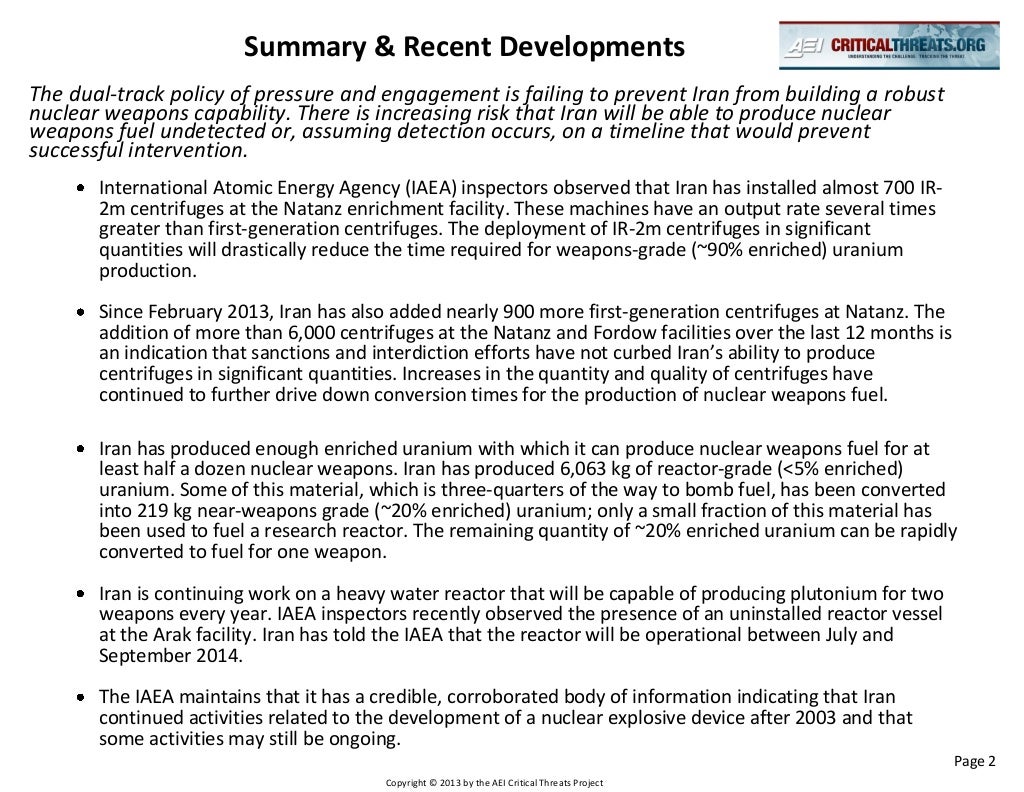
(r) Between September 16, 2012 and August 16, 2013, Iran estimates that it produced 48.7 kg of 20% enriched UF6, for an average monthly production rate of 4.8 kg.
(s) Since July 2010, Iran has been enriching uranium in two interconnected cascades of 164 centrifuges each (328 machines) at the Natanz pilot plant.
(t) Between November 18, 2012 and August 16, 2013, Iran produced 93.5 kg of 20% enriched UF6, for an average monthly production rate of just over 10 kg.
(u) Since mid-December 2011, Iran has been enriching uranium in two interconnected cascades of 174 centrifuges each (348 machines) at the Fordow plant. Iran began enriching uranium in two additional cascades of 174 centrifuges each in late January 2012.
(v) The Fordow plant is designed to contain up to 2,976 centrifuges in 16 cascades. As of November 2013, 2,710 machines were installed.
(w) Based on the assumptions set forth above (see note q), Iran would need approximately 292 SWUs to bring 140 kg of 20% enriched UF6 to weapon grade. See the SWU calculator published by URENCO, a European uranium enrichment consortium: web.archive.org/web/20021226100607/www.urenco.de/trennarbeit/swucal_e.html.
(x) If 292 SWUs are needed to bring a bomb’s worth of 20% enriched UF6 to weapon-grade, and if the 2,710 IR-1 centrifuges installed at Iran’s Fordow enrichment plant were to achieve the same average production rate as those in the main enrichment plant at Natanz (.76 SWU per machine), then it would take less than two months to achieve 292 SWUs at the Fordow plant.
(y) Thomas B. Cochran and Christopher E. Paine, “The Amount of Plutonium and Highly Enriched Uranium Needed for Pure Fission Nuclear Weapons,” (Washington, DC: Natural Resources Defense Council, revised April 13, 1995).
[b] According to the IAEA, Iran had an inventory of 7,451 kg of low-enriched UF6 as of October 21, 2012, based on production from the beginning of operations in February 2007. Iran produced a further 2,906 kg of this material through August 10, 2013, for a total stockpile of 10,357 kg.
[c] According to the IAEA, Iran has used some of its stockpiled low-enriched UF6 (~2,880 kg) for the production of 20% enriched uranium gas. Therefore, Iran had approximately 7,154.3 kg of low-enriched UF6 left as of mid-August, 2013.
(d) Iran estimates that it produced a total of 2,253 kg of low-enriched UF6 over 293 days, from October 22, 2012 to August 10, 2013, for an average daily production rate of 7.7 kg.
(e) This is assuming uranium tails of 1% U-235, a feed assay of 3.5% U-235, a product assay of 90% U-235, a 20% loss of material during processing, and that 16 kg of finished uranium metal enriched to 90% are needed for a bomb. See the SWU calculator published by URENCO, a European uranium enrichment consortium: web.archive.org/web/20021226100607/www.urenco.de/trennarbeit/swucal_e.html.
(f) The Separative Work Unit is the standard measure of the effort required to increase the concentration of the fissionable U-235 isotope. See www.urenco.com/Content/89/Glossary.aspx.
(g) Based on the assumptions set forth above (see note e), Iran would need approximately 955 SWUs to bring 1,053 kg of low-enriched UF6 to weapon grade. See the SWU calculator published by URENCO, a European uranium enrichment consortium: web.archive.org/web/20021226100607/www.urenco.de/trennarbeit/swucal_e.html.
(h) If 1,053 kg of low-enriched uranium are required to produce a bomb’s worth of weapon-grade uranium (see note e), the 7,154.3 kg of low-enriched uranium in Iran’s stockpile as of November 2013 might be sufficient to fuel about six first-generation implosion bombs. This number takes into account the conversion of almost one third of Iran’s low-enriched UF6 stockpile to 20% enriched uranium gas
(i) The IAEA estimates the conversion time for low-enriched uranium to weapon-grade uranium metal to be approximately 3-12 months (www-pub.iaea.org/MTCD/publications/PDF/nvs-3-cd/PDF/NVS3_prn.pdf).
(j) According to the IAEA, Iran had produced about 1,010 kg of low-enriched UF6 by late January 2009. Given the average daily production rate of this material at the time, Iran's stockpile probably contained the requisite 1,053 kg by the following month.
(k) As of August 24, 2013, Iran claimed to be operating 52 cascades (~8,800 centrifuges) in Production Hall A of the Natanz Fuel Enrichment Plant.
(l) Iran's IR-1 centrifuge is estimated to have an annual enrichment capacity of about 2 SWU. Iran, however, has been achieving a lower ouput. For instance, between October 2012 and August 2013, during which time Iran is estimated to have been operating an average of 9,000 centrifuges, 2,253 kg of low-enriched UF6 were produced. Assuming a product assay of 3.5% U-235 and tails of .4% U-235, this amounts to about 5,538 SWUs (6,818 SWUs over one year), or about .76 SWU per machine.
(m) If each of Iran’s 8,800 centrifuges produces an average of .76 SWUs per year, their total output over one year would be 6,688 SWUs, or 557 SWUs per month. Thus, it would take 1.7 months to produce 955 SWUs.
(n) According to the IAEA, as of November 2013, a total of 15,420 centrifuges (90 cascades) had been fully installed in Production Hall A of the Natanz Fuel Enrichment Plant. As of that date, preparatory installation work had been completed for a further 36 centrifuge cascades. The cascades contain first-generation IR-1 centrifuges of either 164 or 174 machines each. An avearge of 170 machines per cascade has been used to estimate the total number of centrifuges.
(o) Iran is producing 20% enriched UF6 at both its Natanz pilot plant and its Fordow enrichment plant, allegedly for the purpose of fueling the Tehran Research Reactor. According to the IAEA, Iran has produced an estimated 410.4 kg of this material through November 2013. The IAEA has verified that Iran produced 129.1 kg of this material between February 9, 2010 and September 15, 2012 at Natanz. Since then, Iran has produced an estimated 48.7 kg of 20% enriched UF6 at Natanz. The IAEA has also verified that Iran produced 101.2 kg of 20% enriched UF6 at the Fordow plant between December 11, 2011 (when production began) and November 17, 2012. Iran estimates that it produced a further 93.5 kg at Fordow through August 16, 2013.
(p) According to the IAEA, 196 kg remained in gaseous form and 213.5 kg had been converted into reactor fuel as of November 2013.
(q) This is assuming uranium tails of 1% U-235, a feed assay of 19.75% U-235, a product assay of 90% U-235, a 20% loss of material during processing, and that 16 kg of finished uranium metal enriched to 90% are needed for a bomb core. See the SWU calculator published by URENCO, a European uranium enrichment consortium: web.archive.org/web/20021226100607/www.urenco.de/trennarbeit/swucal_e.html.

(r) Between September 16, 2012 and August 16, 2013, Iran estimates that it produced 48.7 kg of 20% enriched UF6, for an average monthly production rate of 4.8 kg.
(s) Since July 2010, Iran has been enriching uranium in two interconnected cascades of 164 centrifuges each (328 machines) at the Natanz pilot plant.
(t) Between November 18, 2012 and August 16, 2013, Iran produced 93.5 kg of 20% enriched UF6, for an average monthly production rate of just over 10 kg.
(u) Since mid-December 2011, Iran has been enriching uranium in two interconnected cascades of 174 centrifuges each (348 machines) at the Fordow plant. Iran began enriching uranium in two additional cascades of 174 centrifuges each in late January 2012.
(v) The Fordow plant is designed to contain up to 2,976 centrifuges in 16 cascades. As of November 2013, 2,710 machines were installed.
(w) Based on the assumptions set forth above (see note q), Iran would need approximately 292 SWUs to bring 140 kg of 20% enriched UF6 to weapon grade. See the SWU calculator published by URENCO, a European uranium enrichment consortium: web.archive.org/web/20021226100607/www.urenco.de/trennarbeit/swucal_e.html.
(x) If 292 SWUs are needed to bring a bomb’s worth of 20% enriched UF6 to weapon-grade, and if the 2,710 IR-1 centrifuges installed at Iran’s Fordow enrichment plant were to achieve the same average production rate as those in the main enrichment plant at Natanz (.76 SWU per machine), then it would take less than two months to achieve 292 SWUs at the Fordow plant.
(y) Thomas B. Cochran and Christopher E. Paine, “The Amount of Plutonium and Highly Enriched Uranium Needed for Pure Fission Nuclear Weapons,” (Washington, DC: Natural Resources Defense Council, revised April 13, 1995).


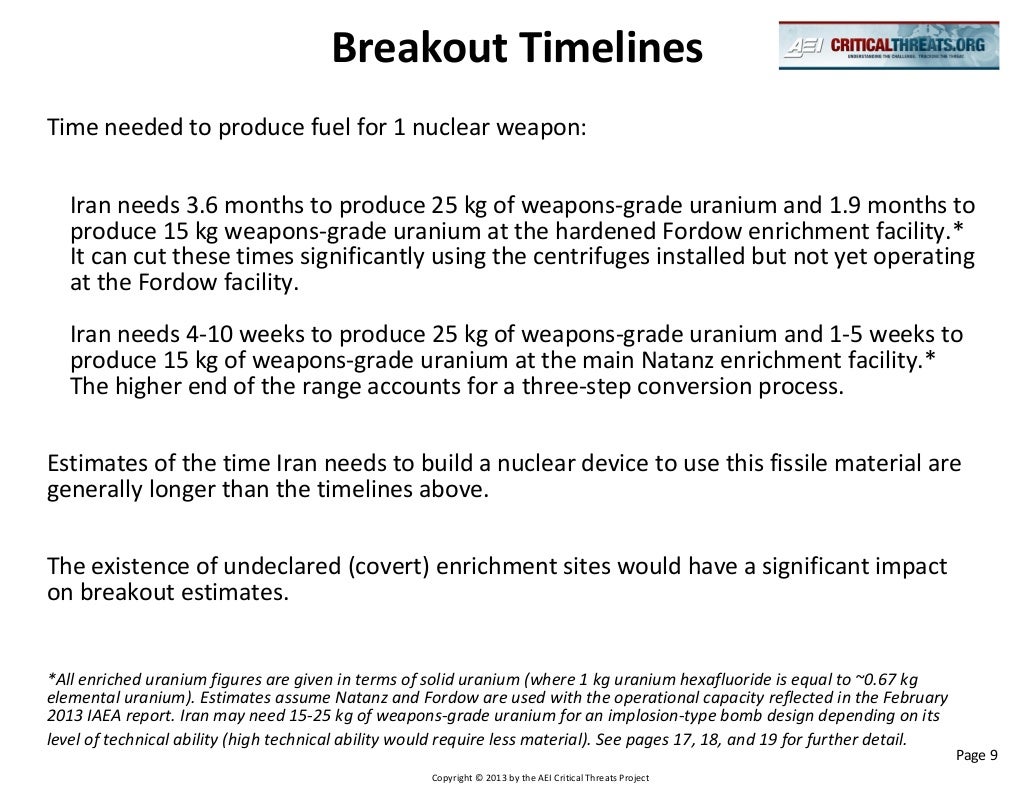
No comments:
Post a Comment